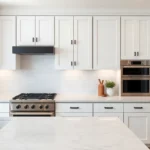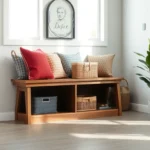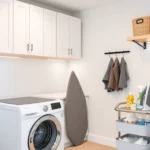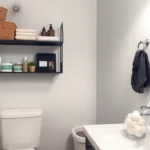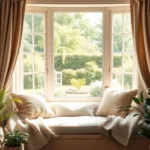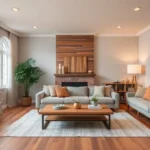Sunken living rooms bring an undeniable sense of sophistication and visual drama to any home. These conversation pits create intimate gathering spaces that naturally draw people together while adding architectural interest that’s both timeless and surprisingly versatile.
We’ve seen sunken living rooms make a major comeback in modern interior design, and it’s easy to understand why. They offer a unique opportunity to define spaces without walls, create cozy entertainment areas, and add depth to open floor plans. Whether you’re working with an existing sunken space or considering creating one, the design possibilities are endless.
From sleek contemporary layouts with built-in seating to bohemian-inspired retreats filled with plush cushions and warm textures, we’ll explore creative ideas that transform these architectural features into stunning focal points. Let’s jump into inspiring concepts that’ll help you maximize both style and functionality in your sunken living space.
Create a Cozy Conversation Pit With Built-In Seating
Built-in seating transforms your sunken living room into an intimate gathering space that naturally draws people together. We’ve found that incorporating permanent seating answers maximizes both comfort and visual appeal while creating defined zones within the lowered area.
Design L-Shaped Banquette Seating
L-shaped banquettes offer the perfect foundation for your sunken conversation pit by providing ample seating that follows the room’s natural contours. We recommend positioning the longer section along your main wall and wrapping the shorter side around a corner to create an enclosed feeling. Custom upholstery in durable fabrics like performance velvet or linen blends ensures your seating withstands daily use while maintaining elegance.
Built-in banquettes eliminate the need for multiple separate furniture pieces and create clean sight lines throughout your sunken space. Professional contractors can construct these seating areas with sturdy plywood frames and high-density foam cushioning for lasting comfort. We suggest incorporating a mix of throw pillows in complementary colors and textures to add visual interest and extra support for guests.
Add Plush Floor Cushions and Pillows
Floor cushions create flexible seating options that enhance the relaxed atmosphere of your sunken living room conversation pit. Oversized Moroccan poufs, Japanese zabuton cushions, and bohemian floor pillows provide comfortable alternatives to traditional seating arrangements. We recommend choosing cushions with removable covers in washable fabrics for easy maintenance and seasonal updates.
Layering different sizes and heights of floor cushions adds visual depth while accommodating various seating preferences throughout your space. Large 24-inch square cushions work well for primary seating, while smaller 16-inch rounds serve as footrests or additional perches. Strategic placement of these soft furnishings around your built-in seating creates an inviting lounge atmosphere that encourages guests to settle in and stay awhile.
Install Hidden Storage Under Bench Seating
Hidden storage compartments beneath your built-in seating maximize functionality without compromising the clean aesthetic of your sunken living room. We design lift-up seat cushions with hydraulic hinges that reveal spacious storage areas perfect for blankets, board games, or seasonal decorations. This clever solution keeps your conversation pit organized while maintaining the streamlined look that makes sunken spaces so appealing.
Custom storage benches can include divided compartments to separate different types of items and prevent clutter from accumulating. Professional installation ensures proper weight distribution and smooth operation of storage mechanisms over time. We’ve found that incorporating LED strip lighting inside storage compartments makes it easier to locate items while adding a subtle ambient glow to your sunken seating area.
Define the Space With Strategic Lighting Solutions

Lighting transforms your sunken living room from a simple architectural feature into a dramatic focal point that feels both intimate and sophisticated. Strategic placement of various light sources creates layers of illumination that enhance the space’s unique depth and character.
Install Recessed Ceiling Lights Above the Sunken Area
Recessed ceiling lights create a sense of depth and highlight the sunken space’s architectural boundaries. We recommend installing these fixtures directly above the seating area to provide general illumination while emphasizing the room’s lowered floor level. Positioning them in a grid pattern ensures even light distribution across the entire sunken area.
Dimmer switches allow us to adjust the lighting intensity based on the time of day and activity. Bright settings work well for reading or entertaining, while softer levels create a cozy atmosphere for intimate conversations. The recessed design maintains clean lines and doesn’t interfere with the room’s visual flow.
Add Floor Lamps at Different Heights
Floor lamps at varying heights add warmth and create ever-changing lighting layers throughout your sunken living room. We suggest placing taller arc lamps behind seating to provide task lighting for reading, while shorter table lamps on side tables offer ambient illumination at eye level.
Mixing lamp heights creates visual interest and prevents the space from feeling flat or monotonous. This approach allows us to illuminate different zones within the sunken area while maintaining the intimate atmosphere these spaces are known for. Choose lamps with adjustable features to customize lighting direction and intensity.
Use LED Strip Lighting Under Seating Edges
LED strip lighting under seating edges provides a modern and cozy ambiance that defines the sunken area’s perimeter. We install these strips along the bottom edges of built in seating or floating furniture to create a gentle glow that outlines the space’s boundaries.
This subtle lighting technique makes the sunken area feel like it’s floating while providing safety illumination for the step down. The warm glow from LED strips creates a welcoming atmosphere without being too bright or overwhelming. Smart LED strips offer color changing options and dimming capabilities for complete customization.
Choose the Perfect Flooring Materials for Your Sunken Living Room

Selecting the right flooring material for your sunken living room creates the foundation for both style and functionality. We’ll explore three top flooring options that enhance the unique characteristics of these conversation pit spaces.
Select Durable Hardwood for Seamless Transitions
Hardwood flooring creates an excellent foundation for sunken living rooms by providing seamless transitions between different floor levels. We recommend this material because it withstands heavy foot traffic while maintaining its elegant appearance over time. Durable hardwood options like oak, maple, or hickory offer the strength needed for high-use conversation areas.
Installing the same hardwood throughout your main floor and sunken area creates visual continuity that makes the space feel cohesive. We suggest using wider planks to minimize seams and enhance the room’s spacious feel. The natural grain patterns in hardwood add texture and warmth that complements the intimate atmosphere of sunken living spaces.
Consider Luxury Vinyl Plank for Easy Maintenance
Luxury Vinyl Plank offers versatile aesthetics and easy maintenance that make it ideal for sunken living rooms where spills or moisture might occur. We appreciate LVP’s ability to mimic the appearance of hardwood while providing superior water resistance and durability. This flooring material handles the unique challenges of sunken spaces without compromising on style.
Modern LVP options come in various wood-look designs that complement conversation pit layouts perfectly. We find that click-lock installation systems make LVP particularly suitable for DIY projects in sunken areas. The material’s flexibility allows it to handle minor settling or movement that can occur in below-grade installations.
Install Area Rugs to Add Warmth and Texture
Area rugs introduce warmth and texture while defining different seating areas within your sunken living room space. We recommend using large area rugs that anchor furniture groupings and create visual boundaries in your conversation pit. These textile elements soften the hard surfaces typical in sunken areas while adding color and pattern variety.
Strategic rug placement helps establish intimate zones for different activities like reading or socializing. We suggest choosing rugs with low pile heights to prevent tripping hazards when transitioning between floor levels. Natural fiber rugs like wool or jute provide durability and comfort that enhance the cozy atmosphere these spaces are designed to create.
Design Multi-Level Seating Arrangements

Multi-level seating arrangements transform sunken living rooms into ever-changing social spaces that visually organize different zones while encouraging natural interaction. This strategic approach creates distinct areas for lounging, conversation, and entertainment through thoughtful furniture placement and elevation changes.
Combine Floor Seating With Traditional Furniture
Floor seating options like large floor cushions and bean bags create an intimate, relaxed atmosphere when paired with conventional sofas and chairs. We recommend mixing modular floor sofas with traditional furniture to accommodate various preferences and activities throughout the space. This combination approach makes the room adaptable for both quiet relaxation and lively social gatherings.
Bean bags and oversized floor pillows offer comfortable alternatives that guests can easily move around the sunken area. Modular sofas positioned at the room’s perimeter work beautifully with central floor seating arrangements. Large floor cushions in rich fabrics add texture while providing flexible seating that adapts to different group sizes and activities.
Create Tiered Seating for Better Conversation Flow
Tiered seating arrangements use the sunken area’s natural elevation changes to position participants at comfortable eye levels for enhanced conversation flow. Built-in steps around the perimeter create natural seating platforms that encourage face-to-face interaction among guests. We find that layered seating heights help establish intimate conversation zones while maintaining an open, welcoming layout.
Built-in benches along different levels provide permanent seating that follows the room’s architectural lines. Low-profile platforms around the sunken area’s edges offer additional seating that doesn’t obstruct sight lines. Strategic placement of seating at varying heights ensures everyone feels included in group discussions and social activities.
Add Ottomans and Poufs for Flexible Seating Options
Ottomans and poufs serve as movable seating answers that we can rearrange based on the number of guests and exact activities. These versatile pieces function as comfortable seats, footrests, or even casual side tables when needed. Round poufs work particularly well in sunken living rooms because they don’t create visual barriers and can easily fit into corners or between larger furniture pieces.
Storage ottomans provide dual functionality by offering seating while hiding blankets, pillows, or entertainment accessories. Upholstered poufs in coordinating fabrics tie together the room’s color scheme while adding soft textures. We suggest choosing ottomans with sturdy construction that can support adult weight while maintaining their shape over time.
Incorporate Natural Elements and Greenery

Bringing nature into your sunken living room creates a seamless bridge between indoor comfort and outdoor tranquility. These organic touches transform the space into a living sanctuary that feels both grounded and refreshing.
Add Built-In Planters Around the Perimeter
Built-in planters along the sunken area’s edges create a natural boundary that softens the architectural transition. We recommend incorporating these planters into the design phase to ensure proper drainage and electrical connections for grow lights if needed.
Linear planters work exceptionally well with rectangular sunken spaces, allowing you to plant ornamental grasses like fountain grass or bamboo for vertical interest. Curved planters complement circular or oval conversation pits, creating flowing lines that enhance the room’s organic feel.
Selecting plants becomes crucial for maintaining year-round appeal and manageable care routines. Low-maintenance options include snake plants, pothos, and ZZ plants that thrive in various lighting conditions. These hardy varieties maintain their lush appearance while requiring minimal attention from busy homeowners.
Hang Plants From the Ceiling Above
Suspended greenery draws the eye upward and creates vertical layers that enhance the sunken area’s depth perception. Hanging planters positioned at varying heights establish visual rhythm while maintaining clear sight lines for conversation.
Macrame hangers add textural interest and bohemian charm to contemporary sunken living rooms. We suggest using sturdy ceiling anchors rated for at least 50 pounds to safely support larger planters filled with trailing plants like string of pearls or ivy.
Ceiling-mounted track systems offer flexibility for repositioning plants based on seasonal light changes or room rearrangements. These systems work particularly well in sunken areas with high ceilings, allowing you to create dramatic cascading displays that frame seating areas beautifully.
Use Natural Stone or Wood Accents
Natural stone accents along retaining walls transform structural necessities into striking design features. Stacked stone veneer, natural river rock, or polished granite create texture variations that catch light differently throughout the day.
Wood elements bring warmth and organic appeal to sunken living rooms through ceiling beams, accent walls, or built-in shelving. Reclaimed barn wood adds rustic character, while sleek walnut or teak complements modern furnishings with sophisticated grain patterns.
Combining stone and wood creates ever-changing material contrasts that enhance the space’s natural aesthetic. We often pair rough stone textures with smooth wood finishes to establish visual balance while maintaining the earthy, grounded feeling that makes sunken living rooms so appealing.
Maximize Storage in Your Sunken Living Room Design

Strategic storage answers transform your sunken living room into an organized haven while maintaining its sophisticated aesthetic. We’ll explore clever ways to integrate storage that enhances both function and style.
Build Custom Shelving Into the Walls
Built-in wall shelving creates a sleek, streamlined appearance that perfectly complements your sunken living room’s architectural lines. We recommend installing floor-to-ceiling bookcases that follow the room’s contours, providing ample space for books, decorative objects, and entertainment equipment. Custom shelving units can incorporate different compartment sizes to accommodate various items, from large art books to small collectibles.
Recessed wall niches offer another elegant storage option that doesn’t protrude into your living space. These built-in features can house speakers, lighting fixtures, or display items while maintaining clean sight lines throughout the room. We suggest adding adjustable shelving within these niches to accommodate changing storage needs over time.
Create Hidden Storage Under Steps
Step storage maximizes every inch of your sunken living room’s transition area while keeping essential items within easy reach. We recommend installing pull-out drawers beneath each step, creating discrete compartments for throw blankets, pillows, and seasonal decorations. These hidden storage answers maintain the room’s visual flow while providing practical organization.
Built-in cabinets under the step area can accommodate larger items like board games, extra linens, or electronic equipment. We suggest adding soft-close hinges and interior lighting to make these spaces more functional and user-friendly. Custom compartments can be designed to fit exact items, ensuring everything has its designated place.
Add Floating Shelves for Display Items
Floating shelves create visual interest at multiple heights while keeping your sunken living room’s floor space open and uncluttered. We recommend installing these shelves at varying levels around the room’s perimeter to display books, plants, and decorative accessories. This approach adds personality without overwhelming the space’s clean lines.
Corner floating shelves make excellent use of otherwise wasted wall space, providing additional display areas for smaller items. We suggest grouping shelves in odd numbers and varying their lengths to create ever-changing visual compositions. LED strip lighting underneath each shelf can highlight your displayed items while adding ambient lighting to enhance the room’s cozy atmosphere.
Enhance Comfort With Temperature Control Features

Temperature control transforms your sunken living room into a year-round haven that’s perfectly comfortable regardless of the season. We’ll explore three essential features that maintain optimal comfort while improving your space’s functionality and appeal.
Install Radiant Floor Heating Systems
Radiant floor heating systems deliver consistent warmth directly from below, making them ideal for sunken living rooms where cold air naturally settles. These systems eliminate the chill factor that can make lower level spaces uncomfortable during colder months.
Energy efficient operation characterizes radiant heating, as it uses 15-30% less energy than traditional forced air systems. Floors warm evenly across the entire sunken area, creating a cozy atmosphere that encourages extended lounging and socializing.
Installation flexibility allows you to choose between electric mats for smaller spaces or hydronic systems for larger sunken areas. Electric radiant systems work well under tile, stone, or luxury vinyl flooring, while hydronic systems integrate seamlessly with any flooring material you’ve selected.
Silent operation means no noisy fans or blowers disturb your peaceful retreat. Temperature controls let you preset comfortable levels throughout the day, ensuring your sunken space maintains perfect warmth when you need it most.
Add Ceiling Fans for Better Air Circulation
Ceiling fans improve air circulation in sunken living rooms, preventing stagnant air and maintaining comfortable temperatures throughout the space. Proper air movement ensures your lower level area doesn’t become stuffy or overly warm during summer months.
Strategic placement above the sunken area creates optimal airflow patterns that distribute conditioned air evenly. Choose fans with reversible motors to push warm air down in winter and pull cool air up in summer, maximizing your HVAC system’s efficiency.
Blade span selection depends on your sunken area’s dimensions, with 52-inch fans working well for spaces up to 225 square feet. Larger sunken rooms benefit from 60-inch fans or multiple smaller units positioned strategically throughout the space.
Design coordination ensures your ceiling fans complement your existing decor rather than competing with it. Modern flush mount styles work particularly well in sunken areas with lower ceilings, while traditional designs suit spaces with higher clearances.
Consider a Fireplace Feature Wall
Fireplaces create dramatic focal points while providing both warmth and visual interest to your sunken living room design. Positioning a fireplace along one wall of your sunken area establishes a natural gathering point that draws people into the space.
Linear gas fireplaces offer clean lines and modern aesthetics that complement contemporary sunken room designs. These units provide instant warmth with minimal maintenance, making them practical choices for year-round comfort enhancement.
Installation options include built-in wall units, corner installations, or double-sided designs that serve adjacent rooms. Electric fireplaces offer flexibility in placement since they don’t require venting, allowing you to position them wherever they’ll have the greatest visual impact.
Heat distribution from fireplaces warms the sunken area naturally, as warm air rises and circulates throughout the space. Combining fireplace heating with ceiling fans creates optimal air circulation that maintains consistent temperatures while reducing overall energy costs.
Create Visual Interest With Color and Texture Schemes

Sunken living rooms provide the perfect canvas for experimenting with ever-changing color palettes and rich textural elements that elevate these architectural features into stunning focal points. We can transform these intimate spaces by strategically combining visual elements that create depth and character.
Use Bold Accent Walls to Define the Space
Statement walls serve as powerful design anchors that emphasize the unique architecture of sunken living areas. We recommend selecting one wall as your focal point and painting it in a bold, contrasting color that complements your neutral base palette. Deep navy blues, rich emerald greens, or warm terracotta tones create dramatic backdrops that naturally draw the eye downward into the sunken space.
Patterned wallpaper offers another sophisticated approach to defining these intimate areas. Textured wallpapers with geometric patterns or organic motifs add visual weight without overwhelming the space. Consider large-scale patterns that won’t compete with your furniture arrangement, allowing the accent wall to frame your seating area beautifully.
Strategic placement of accent walls works best on the wall opposite your main seating arrangement or behind built-in features like fireplaces. This positioning creates natural sight lines that guide guests into the conversation area while maintaining the cozy atmosphere that makes sunken living rooms so appealing.
Layer Different Textures in Fabrics and Materials
Fabric combinations create the foundation for rich, tactile experiences in sunken living spaces. We suggest mixing smooth fabrics like leather or silk with rougher textures such as bouclé or tweed in your upholstery choices. This contrast adds visual depth while providing varied tactile experiences for guests.
Material diversity throughout the space prevents monotony and creates captivating visual landscapes. Combine warm wood elements with cool metal accents and reflective glass surfaces to establish ever-changing interplay between different surfaces. Natural stone or concrete elements can ground the space while adding architectural weight to the design.
Textile layering extends beyond furniture to include window treatments, area rugs, and decorative accessories. Choose curtains in flowing fabrics like linen or silk that contrast with structured upholstery, creating movement and softness that balances the room’s angular architecture.
Add Colorful Throw Pillows and Blankets
Vibrant throw pillows serve as the easiest way to inject personality and seasonal color into your sunken living room design. We recommend selecting pillows in bold, contrasting colors that complement your accent wall while adding unexpected pops of energy to neutral furniture pieces. Mix different sizes and shapes to create visual rhythm across your seating arrangement.
Textured throw blankets provide both comfort and style while reinforcing your layered design approach. Choose blankets with interesting weaves like chunky knits, faux fur, or woven patterns that invite touch and add visual weight to your seating areas. Drape them casually over furniture arms or fold them neatly in baskets for easy access.
Color coordination between pillows and blankets creates cohesive design stories while maintaining flexibility for seasonal updates. Select a core palette of three to four colors that appear throughout your accessories, allowing you to swap pieces easily without disrupting the overall harmony of your sunken living space.
Plan Safety Features and Accessibility Options

Safety considerations become paramount when designing sunken living rooms, as the elevation changes can pose risks without proper precautions. We’ll explore essential safety features and accessibility options that ensure your sunken space remains both beautiful and secure for all users.
Install Proper Railings and Handholds
Railings provide essential fall prevention for deeper sunken areas, particularly where the elevation drop exceeds 12 inches. Local building codes in many states require proper railings when the sunken area reaches certain depths, making compliance a legal necessity alongside safety benefits. We recommend installing sleek glass panels or metal railings that complement your design aesthetic while meeting safety standards.
Handholds offer additional security for users transitioning between floor levels, especially beneficial for elderly family members or guests with mobility concerns. Strategic placement of handholds along walls adjacent to steps creates natural support points without disrupting the room’s visual flow. Custom fabricated handholds can match your existing hardware finishes, maintaining design cohesion while prioritizing user safety.
Built-in armrests along seating edges serve dual purposes as both comfort features and subtle safety supports. These integrated elements help users navigate the space confidently while preserving the clean lines characteristic of modern sunken living room designs.
Add Non-Slip Surfaces on Steps
Non-slip surfaces significantly reduce the risk of slipping and falling when moving between different floor levels in your sunken living room. Textured stone, rubber inserts, or specialized non-slip coatings on step surfaces provide essential traction without compromising visual appeal. We suggest selecting materials that blend seamlessly with your chosen flooring while offering superior grip performance.
Contrasting step edges enhance visibility and safety by clearly defining each level change through visual differentiation. Metal or wood nosings in complementary finishes create distinct boundaries that help users judge step depth and placement accurately. These safety features become especially important in lower light conditions or evening entertainment scenarios.
Carpet runners with anti-slip backing offer another effective solution for wooden or stone steps, providing both traction and sound dampening benefits. Choose low-pile carpets in durable materials that withstand heavy foot traffic while maintaining their non-slip properties over time.
Ensure Adequate Lighting for Safe Navigation
Proper lighting helps users clearly see step differences and level changes, reducing accident risks throughout your sunken living area. Step lighting systems installed directly into risers or along step edges provide targeted illumination that defines each level transition. LED strip lights offer energy-efficient answers that can be dimmed or adjusted based on time of day and usage patterns.
Recessed floor lights positioned strategically around the sunken area’s perimeter create ambient lighting that highlights the space boundaries without creating glare. These fixtures should provide consistent illumination across all transition zones while complementing your overall lighting design scheme.
Motion-activated lighting systems automatically illuminate pathways when movement is detected, ensuring safe navigation during nighttime hours. Smart lighting controls allow you to program different lighting scenarios for various activities, from bright task lighting for reading to subtle ambient lighting for entertaining guests.
Conclusion
Transforming your sunken living room into a stunning focal point requires thoughtful planning and creative vision. We’ve explored many design possibilities that showcase how these unique spaces can elevate your home’s aesthetic while maximizing functionality.
The key lies in balancing comfort with style through strategic seating arrangements built-in storage answers and proper lighting. Whether you’re drawn to cozy conversation pits or prefer multi-level entertaining spaces the options are endless.
Remember that safety and accessibility should never be compromised for design. With the right combination of materials colors and textures your sunken living room will become a sophisticated retreat that brings family and friends together for years to come.
Frequently Asked Questions
What are the main benefits of having a sunken living room?
Sunken living rooms add architectural sophistication and visual drama to homes while fostering intimacy and conversation. They create natural zones for different activities, enhance the sense of space through elevation changes, and serve as unique focal points that work with various design styles from contemporary to bohemian.
How can I create comfortable seating in a sunken living room?
Focus on built-in seating solutions like L-shaped banquettes with custom upholstery for durability. Add plush floor cushions and pillows for flexibility, and incorporate hidden storage under bench seating. Consider multi-level arrangements combining floor seating with traditional furniture to accommodate different preferences and activities.
What lighting works best for sunken living rooms?
Install recessed ceiling lights above the sunken area with dimmer switches for adjustable ambiance. Add floor lamps at varying heights for warmth and visual interest. LED strip lighting under seating edges defines the perimeter while providing safety and modern appeal. Layer different light sources for optimal functionality.
What flooring materials are recommended for sunken living rooms?
Durable hardwood with wider planks creates seamless transitions and spacious feels. Luxury Vinyl Plank (LVP) offers easy maintenance and water resistance for high-traffic areas. Add area rugs with low pile heights for warmth, texture, and safety, choosing natural fibers like wool or jute for durability.
How can I incorporate storage without cluttering the space?
Use built-in wall shelving that follows the room’s contours for books and decor. Create recessed wall niches for discreet storage of electronics and fixtures. Install hidden storage under steps for essentials, and add floating shelves for display without taking floor space. Storage ottomans provide dual functionality.
What safety features should I consider for a sunken living room?
Install railings and handholds in deeper sunken areas, choosing sleek designs that complement your aesthetic. Use non-slip surfaces on steps and ensure adequate lighting with motion-activated systems. Consider textured materials for better grip and maintain clear sight lines for safe navigation throughout the space.
How can I maintain year-round comfort in a sunken living room?
Install radiant floor heating systems for consistent warmth and energy efficiency. Add appropriately sized ceiling fans to improve air circulation and prevent stuffiness. Consider incorporating a fireplace feature wall for both warmth and dramatic focal point appeal while enhancing the overall ambiance.
What design elements add visual interest to sunken living rooms?
Create bold accent walls with contrasting colors or textured wallpapers to define the space. Layer different textures through fabrics and materials for depth and tactile experiences. Use colorful throw pillows and blankets for personality and seasonal updates while maintaining cohesive color coordination throughout.
How can I incorporate natural elements into my sunken living room?
Add built-in planters around the perimeter with low-maintenance plants like snake plants and pothos. Hang plants from the ceiling for vertical layers and enhanced depth. Incorporate natural stone and wood accents to add warmth and texture while creating a seamless bridge between indoor comfort and outdoor tranquility.


